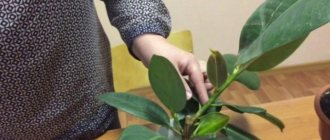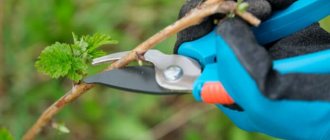Wintering fuchsia in an apartment. How to properly prune and preserve a plant?
Before wintering, fuchsia is pruned, not fertilized and sprayed with a biological product purchased at a flower shop to protect against pests.
Basement or cellar
How to keep a plant in the basement, and what kind of care does it need?
Not everyone has the opportunity to organize the wintering of fuchsia on a glassed-in warm loggia of an apartment or in a bright greenhouse. Wintering goes well in a “dark” room - in the basement, garage or cellar. Before moving it to one of the rooms listed above, trim it and remove the leaves. In the dark, it also “breathes”, just like in the fresh air, consuming nutrients and evaporating water. The room where it will be located must have ventilation. Otherwise, with its appearance, the humidity in the air will increase, which will provoke an outbreak of fungal diseases. The optimal temperature for wintering fuchsia is in a cellar or basement, where the temperature is – +10⁰С.
Look
In the apartment
Not all gardeners have a basement or garage where they can move a pot of fuchsia for the winter. Some have no choice and are forced to bring it home. You can also provide a comfortable winter in an apartment, but only if it is regularly ventilated.
At the beginning of autumn, fuchsia cuttings are transplanted into “poor soil” with a small content of humus for the winter. This slows down the growth of young bushes. If in winter a gardener notices that they are sprouting, he should ruthlessly cut them off and open the window wider to lower the temperature in the room. The shoots do not need to be thrown away. You can try to root them by placing them in water on a well-lit and “warm” windowsill.
If fuchsias wintering in the basement are watered rarely - 1-2 times a month, then plants that winter in the apartment are watered more often.
Note! Due to central heating, the earthen ball dries out faster, and the lack of moisture leads to the death of the flower.
On the day when the gardener brings the fuchsia pot home, he must open the window and set the double-glazed window to minimal ventilation. The window should always be open, except on days when it gets very cold outside.
During the dormant period, fuchsia is even more capricious than during the period of active growth and flowering. It reacts poorly to excess and lack of moisture. Lack of necessary conditions for wintering, increased air humidity and temperature lead to the appearance of insects. Fungicides and insecticides do not always help in combating them, and the plant can only be thrown away.
How to care for a flower on the windowsill?
- Insulating the bottom with polystyrene foam during transplantation helps to avoid rotting of the roots due to cold masses constantly rushing into the room through a slightly open window.
- Dry air protection will be needed if the apartment is hot. To do this, simply cover the fuchsia with plastic wrap.
- Watering should not be frequent or abundant.
- The plant must be treated with special preparations to protect against pests.
- In December and January, the plant is illuminated with lamps, since there is not sufficient lighting during the day.
Maximum ventilation of the window sill. The pot is placed as close to the glass as possible.
Do I need to trim?
You definitely need to prune the plant for the winter, because this is an important stage in growing and it is very important to do it correctly. It is held twice a year. The first time is in the fall, when they move it from the garden to the basement or apartment and it is necessary to provide suitable conditions for hibernation, and the second time is in the spring, in order to form a beautiful bush. Fuchsia is pruned in the fall after it has finished blooming, so as not to provoke the growth of 1-2 trunks and the bush stretching upward. This procedure is necessary for the proper development of the flower next spring.
Choosing a season for pruning fuchsia
Initially, the gardener must figure out when to prune fuchsia and for what purpose. Pruning is done in the spring months, until the time when the plant begins to form buds. With proper manipulation, fuchsia will bloom more abundantly and longer. The plant can also be pruned in the fall. The best period will be the last ten days of October or the beginning of November. This method is suitable for indoor plants. In autumn, gentle pruning is recommended, which concerns the parts of the plant where the flower stalks were.
If the plant is still blooming at this time, it is recommended to postpone the procedure to a later period. You can do pruning in winter. But fuchsia must be pruned before wintering, when the plant enters the dormant phase. To prevent it from weakening, there is no need to trim the shoots to a length of less than 15 centimeters. When the crown is formed, only weak shoots are eliminated. They are thinned out and shortened to 1/3 of the original height.
Wintering fuchsia in the refrigerator. Preparing fuchsias and pelargoniums for wintering: tips from Yulia Minyaeva
At the beginning of the season, many summer residents take pots to the dacha and take them out into the open air. With the onset of cold weather they return home. A plant like this is often planted in the spring, but in the winter it must be dug up and stored for storage.
Geraniums We will talk about how to prepare pelargoniums (geraniums) and fuchsias for wintering.
fuchsia
When bringing a fuchsia (or other indoor plant) into the house that has stood outdoors throughout the warm season, you need to be aware that unwanted “guests” can also enter along with it. These are whiteflies, spider mites, and aphids. Quite quickly, all these pests will spread to other house plants, and then to the seedlings, which you will begin to grow at the right time. To make the autumn transition process painless, it is necessary to pay special attention to pest control. The plant may look completely clean, but after placing it in a warm place, small white butterflies - whiteflies - appear out of nowhere. And the most unpleasant thing is that they settle not only on plants, but also in crevices, where they spend the winter well and wait for seedlings.
Delicate fuchsia A good treatment for Fitoverm, but often it is not strong enough, so I use Aktara. This is a reliable drug, but you need to remember that spraying must be repeated after 5-7 days. You can choose products for treating plants against pests on our market, where products from various online stores are presented. View a selection of the drug "Aktara". Before storing the fuchsia in the cellar (temperature +4...+5°C), I water it, trim it and make a paper cap in the same way as for pelargonium. This will be discussed in more detail below. No more manipulations are required, the plant overwinters well without additional watering or anything else.
pelargonium (geranium)
pelargonium, unfortunately, does not tolerate our winters, and therefore requires temporary relocation to more acceptable conditions. Many people think about how best to preserve this plant during the cold period. I will share my experience. After it's time to remove the geranium from the street, I move the plant into the house, where it sits for about 2 weeks. Watering stops completely, since in winter the geranium enters a dormant period; it almost never blooms at this time.
Pelargonium does not tolerate our winters. If your pelargonium grew in a flowerbed, then in the fall you can dig it up, place it with a lump of earth in a paper (not plastic!) bag, tie it on top and put it in the cellar. Another option is more suitable for plants that were in outdoor flowerpots in the summer. Such pelargonium needs to be transferred to a temporary pot. For further manipulations, you will need a water-based stationery proofreader (for example, “Stroke”), sharp pruning shears, newspapers, paper tape and a hydrogel soaked in water. I cut off all the green branches of the plant to the woody part, leaving a not very beautiful “snatch”. All green leaves from this snag are also removed. Cuts on the branches are treated from rotting with the “Stroke”, the plant itself is watered a little.
A paper cap is formed from newspapers. Now a paper cap is formed from newspapers using tape, and the newspapers are wrapped on top. In this form, the plant is lowered into the cellar (temperature +4...+5°C) and stored all winter.
Newspapers are wrapped on top. In early spring, after removing the cap, the plants do not look very attractive, but after pruning and adding nutritious soil, they quickly wake up.
cuttings
I prepare cuttings from the cut green mass of pelargonium and root them. To do this, I remove the peduncles and most of the leaves, trim them from the bottom to lush greenery and lower them into the prepared hydrogel.
Cuttings are prepared from the cut green mass. After a while, roots will appear, and then I will plant them in pots and place them on a cool windowsill. In the spring I will have at my disposal several fully mature plants with a good root system that can be planted in flower beds and flowerpots. In the next video
clip you will see in detail how pelargonium and fuchsia are prepared for winter. You can also learn how and with what help it is convenient to fix roses when bending down to the ground, and how to insulate them after stable cold weather sets in. I hope my experience in preparing flowers for winter will be useful to you. Share in the comments how you preserve your fuchsias and pelargoniums until spring.
Diseases
The plant very rarely gets sick. Diseases can occur as a result of improper care after pruning . The most common are:
- Rust . The disease can be recognized by the presence of brown spots on the inner surface of the leaf. This disease is fungal and can be introduced as a result of pruning if the tools used for the affected flower are not disinfected. It is urgent to remove the affected leaves and treat with Bordeaux mixture at intervals of 2-3 days.
- Root rot . This disease is formed as a result of improper hydration. A healthy plant has white and elastic roots. If during transplantation it turns out that the roots are dark brown in color, then this is root rot.
Pruning fuchsia is a necessary agrotechnical technique, without which the plant will not bloom actively and luxuriantly. This process is simple, so even a novice gardener can do it. But if this is not done, the plant will take an unattractive shape, the number of buds will decrease, as will their size.
If you find an error, please select a piece of text and press Ctrl+Enter.
Fuchsia is a beautiful indoor plant with lush flowers. The main difference is the bright and unusual flowering. In order to get lush flowering, fuchsia must be pruned correctly.
This procedure is carried out very carefully, following all recommendations and rules. Let's talk about all this in detail in our article. You can also watch a useful video on this topic.
Fuchsia on the balcony in winter. General rules for caring for shrubs
In order for an exotic flower to always please its owner, it needs to create appropriate conditions for growth, flowering and rest during the off-season. Therefore, everyone is interested in how to care for fuchsia growing in open ground and at home in a flower pot.
Let's look at the basic rules for caring for fuchsia at home
- Watering mode. Fuchsia belongs to the category of moisture-loving plants. It responds equally well to both root watering and external spraying. The shrub should be watered daily in small portions. A signal that the plant requires moisture is when the top layer of soil dries to a depth of 1 cm or more. But you should not overuse watering. Excess moisture leads to the development of mold and rotting of roots. You can avoid waterlogging by creating a drainage layer at the bottom of the flowerpot. For this, expanded clay or well-cleaned pebbles are used.
Flower lighting. Despite the fact that fuchsia is a heat-loving flower, it is not recommended to place it in direct sunlight. For this plant, reflected light and even partial shade conditions are quite enough. When choosing a location for a shrub, you need to take into account the contrast factor. Plants with dark-colored flowers need more color, while bright, light-colored flowers do much better in the shade.
Selection of soil mixture etc. It is best to use black soil with the addition of leaf humus for growing shrubs. This composition will provide the root system with nutrients and give it freedom to grow. The plant needs constant feeding. For blooming fuchsia, you need to use biological fertilizers with a minimum nitrogen content. Fertilizers can be applied along with irrigation liquid or by adding them directly to the soil. When winter comes, the plant does not need feeding. It enters a state of rest when there is no need for nutrients.
Temperature maintenance. Despite the fact that fuchsia is native to hot countries, it reacts extremely negatively to high temperatures. When it increases above +25 ºС, the bush becomes lethargic, does not bloom or bear fruit. In summer, the flower must be protected from direct sunlight. To do this, you need to put the flowerpot in a cool place, and create artificial shade for the flower garden.
Features of the procedure: instruments, disinfection
The main tool is a knife or garden shears. It is very necessary to disinfect equipment before the procedure. This will prevent viral diseases that are transmitted through the juice of affected flowers. For disinfection, various compositions containing alcohol are used.
You can use medical sprays, alcohol wipes, or household products such as chlorine and kerosene.
Potassium sulfate disinfects well . Dip the instruments into the solution for a few minutes and then wipe with a clean cloth.
Fuchsia in the apartment. Fuchsia at home and in the garden - how to grow
They are called little ballerinas in fluffy colorful skirts, they are charming and original, and the variety of colors and shapes of flower-skirts is amazing.
If you don't already have this beautiful flower, be sure to get one. Fuchsia can grow at home - it is a houseplant, but in summer it can be planted in a flowerpot in the garden, and it will become the best decoration for your potted garden.
Ampelous forms of fuchsia grow well in hanging flowerpots, forming continuous flowering cascades.
How to grow fuchsia
You can buy fuchsia as an adult plant, or you can buy a cutting and grow it. Cuttings are rooted in water or loose soil with sand. It is better to first plant a young plant in a small pot so that the roots gradually master the entire soil, and only then replant it into a larger volume.
Conditions for fuchsia
Fuchsia is a light-loving plant and is best grown in the brightest window, but in summer it is better to shade the south window a little. It will be good for her on the loggia or balcony.
In the garden, it is better to place a container with fuchsia in light through partial shade - it will not be very comfortable in the bright sun. In extreme heat, flowering stops, the bush begins to dry out, the leaves dry out and may fall off.
Important! Fuchsia does not tolerate overheating of the root system, and to prevent the roots from overheating in the heat, it should be planted in a large ceramic pot.
When fuchsia begins to bloom, it is all covered with its wonderful flowers. Fading flowers must be removed to prevent the formation of seed pods, which can take up all the nutrition.
Remember! When fuchsia blooms, it is undesirable to turn it and rearrange it - this can lead to the dropping of buds.
Abundant flowering takes a lot of energy and nutrients, so fuchsia is regularly fed with complex fertilizers for flowering plants - approximately once every 7-10 days. Water fuchsia regularly and abundantly - under no circumstances should the plant be allowed to dry out. I really like fuchsia and spraying.
Fuchsia in winter
With the onset of cold weather, fuchsia growing in flower pots in the garden is transferred to a cool room (with a temperature of 10–15 ° C) or stored in a dark basement; it is advisable to put indoor fuchsias there as well. From time to time, check the plants to ensure that the soil in the pots is slightly moist.
After such a cold winter, fuchsia will bloom much better next summer.
in spring
In the spring, the plants are transplanted into new containers using fertile soil with the addition of sand. Then the bush is pruned, shortening the grown and elongated shoots. The more often you prune fuchsia, the more side shoots it forms and, accordingly, the more flowers.
Cuttings can be used to root and grow new plants.
There are many beautiful varieties of fuchsias - both bush and hanging. You can plant several plants of different varieties in one pot - it will be a magnificent mixture of luxurious flowers.
Fertilizers
Fertilizing begins immediately after wintering and spring pruning. You need to continue feeding until autumn. In special stores you can purchase fertilizers that are intended for flowering plants.
If you overfeed fuchsia, it will begin to grow foliage, but flowering will be sparse. To prevent this from happening, fertilizers are applied only once every couple of weeks. The composition of the preparations should include nitrogen, phosphorus, potassium and magnesium.
There are some rules that must be followed when feeding a flower after pruning it:
- Fertilizing is done only in moist soil.
- Organic fertilizers need to be diluted with water twice as much as written in the instructions.
- During cold weather, the flower does not need feeding.
Spring Awakening
In mid-February we replant the fuchsia: since it is resistant to constant waterlogging, place a drainage layer at the bottom of the vessel and use a new, loose substrate. During this period, the plant must be thoroughly pruned, otherwise it will be frail and will not bloom.
Wait at least four weeks to apply fertilizer after transplanting. Then you can fertilize every 2 weeks with compounds for balcony plants or fertilizer developed specifically for fuchsia.
You can take flowers out into the open air only when the danger of frost has passed, that is, after mid-May. Fuchsias should be placed in a draft-free location where they will bloom beautifully again next fall.
Interesting! Fuchsias are one of the most useful plants. From spring to autumn, its charming flowers adorn semi-shaded areas of gardens and terraces. They usually spend the winter in a cool and bright place.
Plants such as fuchsia come in many varieties that differ in appearance. They also have different requirements for wintering. Some cannot survive the winter except in a cool and lighted place, but others survive the winter even in the dark. Some species can survive the winter in a warm room.
Diseases
Fuchsia rarely gets sick, most often this happens due to improper care after pruning. The most common ailments:
- Rust. Brown spots on the inside of the leaf are a clear sign of this disease. It could have gotten onto the plant due to poor disinfection of instruments. To get rid of the disease, you must urgently remove the infected leaves and treat with Bordeaux mixture at intervals of 2-3 days.
- Root rot. Appears as a result of excessive moisture. If dark brown roots are noticed during transplantation, this means that the flower has been affected by rot. Such a fuchsia cannot be saved; the only thing that can be done is to cut the cuttings and root them.
- Chlorosis. A flower can get chlorosis if it is watered with tap water. The main symptom is yellowed leaves. To return to a healthy appearance, you need to review the watering regime.
Description of the plant
The plant, due to its flexibility, can develop as an ampelous or pyramidal type.
Fuchsia is often grown as an elegant standard tree. The branches of the ballerina are plastic, forming a crown that cascades down. Fuchsia flowers belong to the axillary variety, they are single and hang downwards. Each flower consists of a corolla-shaped cup, which has four pointed petals. The pistil and bright stamens protrude outward.
Fuchsia was bred more than three hundred years ago: in 1695 by the French botanist C. Plumière. He named the plant in honor of the German botanist Fuchst, who subsequently developed more than 100 varieties of fuchsia.
Ballerina flowers are simple, double and semi-double. They are distinguished by a rich palette of shades: there are white, cream, pink, lilac, orange and even purple. There are multi-colored flowers that combine 2-3 tones.
Fuchsia blooms long and abundantly; during this process, the peduncles droop for a long time, leaning down and, ultimately, wither. Ballerina has a powerful and developed root system, thanks to which it easily tolerates transplantation and propagation. It bears fruit with medium-sized elongated berries that are edible.
Various tinctures, liqueurs, and jams are prepared from fuchsia fruits that grow naturally.
Various crown shapes
By pruning, you can give the fuchsia a shape that fits well into the design of the room or flower garden. If you need a subshrub, cut off the top of a young cutting, leaving 2 pairs of lower buds. New shoots will soon appear from the axils, which will also begin to produce buds. The tops of young shoots should be pinched. At the same time, look at the varietal characteristics of the plant. If the internodes are located far from each other, leave 2 pairs of buds on the shoots, if close, then 3-4. Carry out this procedure on all new shoots until you decide that the crown density is sufficient.
If desired, decorative trees can be grown from upright varieties. To do this, pinch out all the buds that appear below the intended crown. When the plant reaches the desired height, pinch the top and trim the remaining shoots in the same way as for the semi-shrub form. When growing a standard form, you need to remember that the trunks may not withstand heavy loads during heavy flowering and may break. If you want the tree to develop a dense crown, tie it to a support.
The trunk can be given a twisted or curved shape; such plants look impressive and original. If you plant several fuchsias in one pot, you can intertwine or entwine their trunks in various ways. This procedure must be carried out while the shoots are young and bend well. At first, the position of the trunk should be fixed with strong threads, and when the wood becomes hard, the ropes can be removed. An interesting composition can be obtained if several varieties with inflorescences of different shapes and colors are grown in this way.
If you want plants of different heights to grow side by side, pinch their tops at the desired level.
Proper pruning in the fall will help your fuchsia not to lose strength over the winter, and in the spring to produce strong shoots that will produce many flowers. You can limit yourself only to thinning and shortening the branches: this plant is beautiful in its natural form. If you want to give the flower an original shape, cutting and pinching will give you enormous scope for imagination. The combination of ampelous, semi-ampeloid and upright species will allow you to create a decorative composition that will decorate both the flower garden and the interior of the apartment.
goodgrunt.ru











